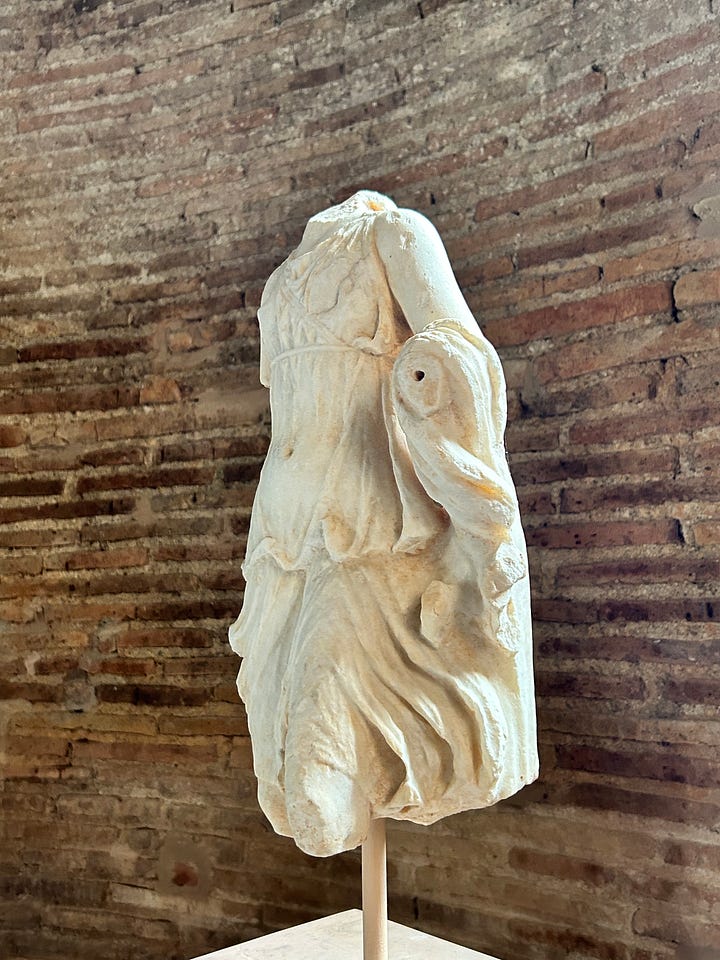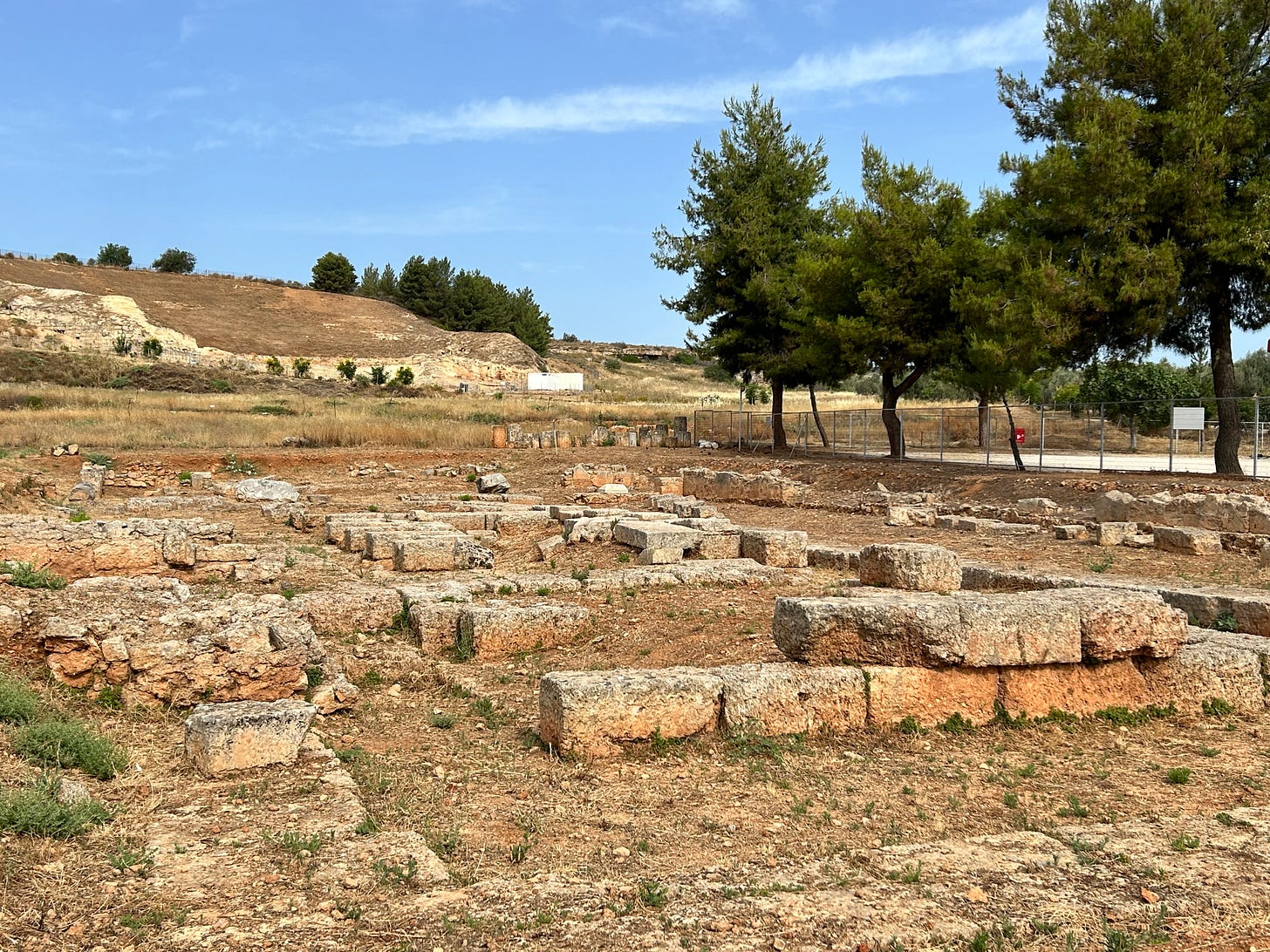Red Stones, Sacred Waters: Finding Artemis Limnaia
The Lady of the Lake and Her Temple at Sikyon
As part of the Artemis Temples Mapping Project in June 2024, our journey led us to the ancient city of Sikyon, Greece, where we explored the remnants of a temple believed to be dedicated to Artemis Limnaia. The day promised to be hot, though the sky was cloudy and (once again) were the only ones on the site. While we knew the temple was dedicated to Artemis, it is always so rewarding to see the ‘official label’ acknowledge her worship here. We spent several hours filming, taking pictures and walking around imagining ancient peoples going about their daily business among the buildings, in the gymnasium and having their lunch in the agora. By the time we tore ourselves away from our ancient dreaming, the sun was high in the sky and we were covered in sheen of hard work mixed with red ‘poros’ sand. We laughed happily, knowing we read every label and documented every stone, and couldn’t wait to get out of the heat in the shade and into the coolness of the museum. Walking into mostly darkness, we were informed the power was out but if we wanted to look around we could try and see whatever we could in the faint light of one back window.
Luckily, neither Sandra nor I, were intimated by our sauna drenched clothes, or the dark of an unlit museum so, phones in hand, we braved the dark rooms. AND, as it so often happens on our expeditions, the lights came on! Yup, and so She lights the way!!
The temple is situated in the northern section of the excavated Agora of Hellenistic Sikyon, a city known in antiquity for its cultural and political prominence. This rectangular Doric structure, measuring approximately 38 meters in length and 11.55 meters in width, is constructed from local reddish poros stone, a material characteristic of the region. The temple’s orientation, running east to west, mirrors the alignment of many Greek sanctuaries, which were often designed to welcome the morning sun—a fitting architectural feature for a goddess so deeply tied to nature. The temple consists of a pronaos (front porch), cella (main chamber), and opisthodomos (rear chamber), elements that underscore its classical design.
A Timeline of Construction and Use
The history of this temple spans centuries, with evidence of multiple building phases reflecting its enduring significance. The earliest phase dates to the 6th century BCE, during the Archaic period of Greek history. Architectural features, including the size of the structure and specific stylistic elements, suggest this initial construction phase. The discovery of mason’s marks on large square slabs that formed the floor adds further credence to this dating. This period aligns with the broader development of Greek temple architecture, which increasingly emphasized monumental structures dedicated to the gods.
In the 4th century BCE, the temple underwent significant repairs or reconstruction. This second phase likely corresponded with a period of renewed prosperity in Sikyon, which saw the city asserting its influence in the Peloponnesian region. The third phase of construction, attributed to the Hellenistic period, may have occurred during the reign of Demetrios Poliorketes after 303 BCE. His campaigns and urban renewal projects left an indelible mark on many Greek cities, and it is plausible that the temple benefited from these initiatives. Unfortunately, the temple met its demise around 250 CE, likely due to a devastating earthquake—a fate that befell many ancient structures in the seismically active region of the Peloponnese.
Transformation into a Christian Basilica
The story of the temple does not end with its destruction. In the Late Roman to Early Christian period, the site was repurposed for a basilica, marking a dramatic shift in its religious function. This new structure incorporated materials from the original temple, including columns and capitals, a practice common in early Christian architecture, which often repurposed elements of pagan sanctuaries. The basilica, dated to the 4th–5th centuries CE, featured intricate floor mosaics and crosses incised on stones, symbols reflecting the new faith that had taken hold in the region. Additionally, the basilica included a square room on its southern side and modifications to the west of the earlier temple, demonstrating how the site continued to evolve over time.
The transformation of the temple into a Christian basilica reflects broader cultural and religious changes that swept through the Roman Empire in late antiquity. Even in its Christianized form, the temple retained echoes of its earlier dedication to Artemis, preserving the memory of the goddess in a landscape increasingly dominated by a new religious paradigm.
Artemis Limnaia: The Goddess of the Lake
The epithet "Limnaia," meaning "of the lake," highlights Artemis’s association with water and wetlands, which were vital to ancient agricultural societies. This connection is especially significant in a region like Sikyon, where the natural landscape played a crucial role in the city’s economic and cultural life. The worship of Artemis Limnaia likely included rituals and offerings tied to the protection and fertility of these aquatic environments, emphasizing the goddess’s role as a guardian of nature. In Greek religion, Artemis frequently took on regional forms that reflected the local landscape, and the temple at Sikyon is a testament to this adaptability.


Archaeological Discoveries and Insights
The excavations of the temple, initiated in the early 20th century, have uncovered a wealth of information about its construction and use. The work of archaeologists such as Anastasios Orlandos and A. Philadelpheus revealed the temple’s layout, construction materials, and phases of development. Inscriptions and votive offerings found at the site provide further evidence for its identification as a sanctuary dedicated to Artemis Limnaia. These artifacts offer glimpses into the lives of the ancient worshippers who came to the temple, leaving behind tokens of their devotion.
The use of local Sikyonian ‘poros’ stone in the temple’s construction is a fascinating detail, as it underscores the integration of the sanctuary into its immediate environment. This material choice also reflects the broader Greek architectural tradition of harmonizing sacred structures with the natural world. Such practices reinforced the connection between the gods and their earthly domains, grounding the divine in the landscapes of everyday life.
Preservation and Modern Relevance
Today, the ruins of the temple remain a poignant reminder of Sikyon’s rich history and the enduring legacy of Artemis’s worship. While much of the structure has been lost to time and natural disasters, the surviving elements continue to inspire awe and curiosity. The site is part of the larger archaeological complex of Sikyon, which includes the Agora, Theatre, Stadium, and Roman Baths. Efforts by the Greek Ministry of Culture and local preservation initiatives aim to safeguard this invaluable cultural heritage for future generations.
As we map the temples of Artemis across the ancient Mediterranean, the site at Sikyon stands out as a remarkable example of the goddess’s multifaceted role in Greek religion. Its layers of history—from its Archaic origins to its Hellenistic grandeur, and later its transformation into a Christian basilica—tell a story of resilience and adaptation that mirrors the evolving religious and cultural landscapes of the ancient world.
Support the Artemis Mapping Project
The Artemis Temples Mapping Project is not just about documenting sites; it’s about connecting with the past and preserving its legacy. The temple of Artemis Limnaia at Sikyon is a vivid reminder of the importance of sacred spaces in ancient life and the enduring power of Artemis as a symbol of nature, protection, and transformation. By supporting archaeological research and preservation, we can ensure that sites like this one continue to teach and inspire us. Join us in celebrating and safeguarding these treasures—whether through sharing this journey, contributing to ongoing projects, or simply spreading the word about Artemis and her temples. Together, we can bring her story to life and honour the enduring spirit of the ancient world.
Ready to dive deeper into the world of ancient goddesses and transformative knowledge? Join me on an unforgettable journey through online courses on the Artemis Centre Learning Platform, exclusive YouTube content with The Goddess Project, and immerse yourself in the mythology of the Greek Artemis with my book She Who Hunts. Whether you're looking to learn, explore, or simply get inspired, there’s something for every curious soul. Take the next step in your goddess adventure—your path to wisdom and empowerment starts here!





Love your contributions to our knowledge
I love how the goddess always seems to test you to determine you really deserve what you’re seeking. The no lights in the museum yet you proceed, then bam! 💥 the lights come back on